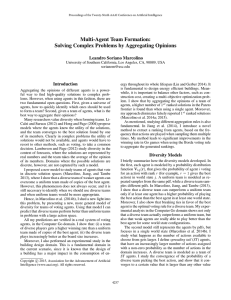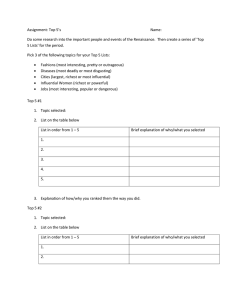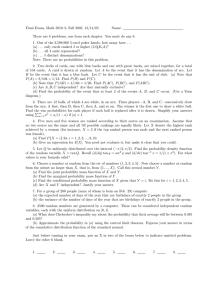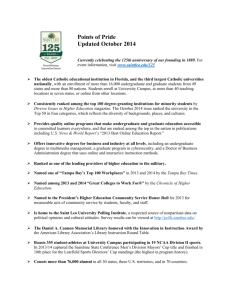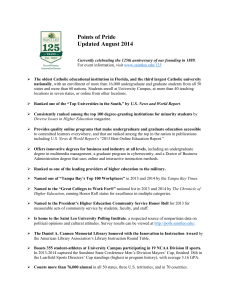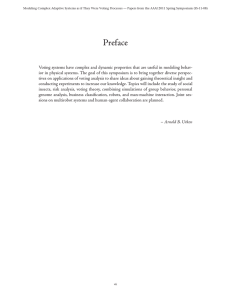Aggregating Opinions to Design Energy-Efficient Buildings
advertisement
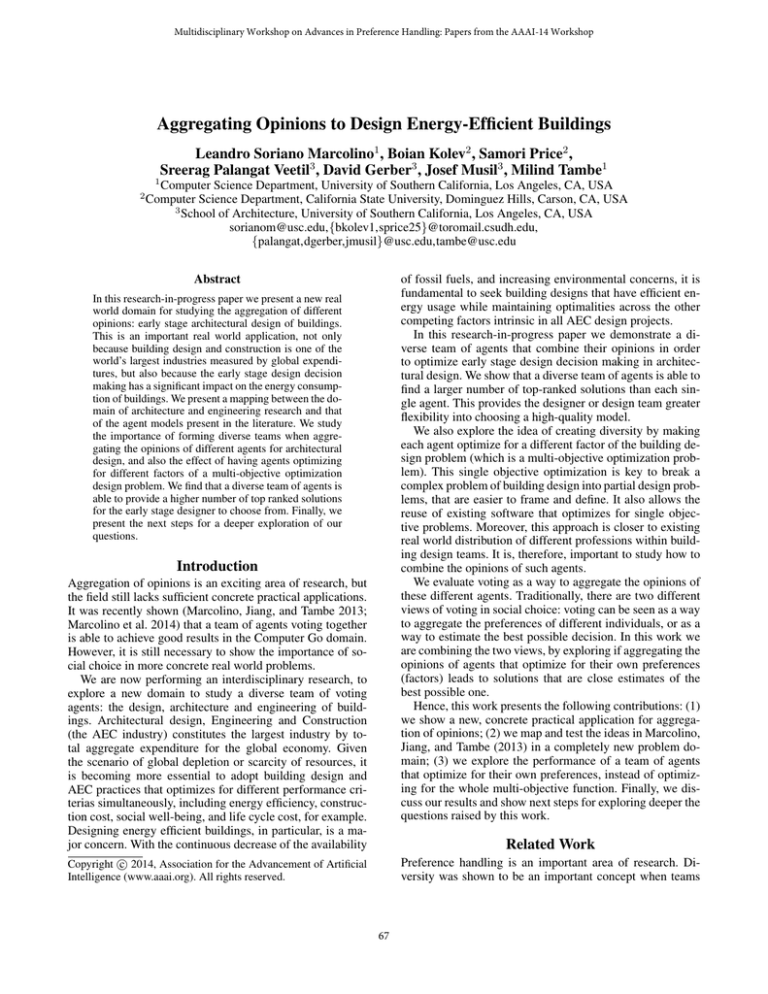
Multidisciplinary Workshop on Advances in Preference Handling: Papers from the AAAI-14 Workshop
Aggregating Opinions to Design Energy-Efficient Buildings
Leandro Soriano Marcolino1 , Boian Kolev2 , Samori Price2 ,
Sreerag Palangat Veetil3 , David Gerber3 , Josef Musil3 , Milind Tambe1
1
2
Computer Science Department, University of Southern California, Los Angeles, CA, USA
Computer Science Department, California State University, Dominguez Hills, Carson, CA, USA
3
School of Architecture, University of Southern California, Los Angeles, CA, USA
sorianom@usc.edu,{bkolev1,sprice25}@toromail.csudh.edu,
{palangat,dgerber,jmusil}@usc.edu,tambe@usc.edu
Abstract
of fossil fuels, and increasing environmental concerns, it is
fundamental to seek building designs that have efficient energy usage while maintaining optimalities across the other
competing factors intrinsic in all AEC design projects.
In this research-in-progress paper we demonstrate a diverse team of agents that combine their opinions in order
to optimize early stage design decision making in architectural design. We show that a diverse team of agents is able to
find a larger number of top-ranked solutions than each single agent. This provides the designer or design team greater
flexibility into choosing a high-quality model.
We also explore the idea of creating diversity by making
each agent optimize for a different factor of the building design problem (which is a multi-objective optimization problem). This single objective optimization is key to break a
complex problem of building design into partial design problems, that are easier to frame and define. It also allows the
reuse of existing software that optimizes for single objective problems. Moreover, this approach is closer to existing
real world distribution of different professions within building design teams. It is, therefore, important to study how to
combine the opinions of such agents.
We evaluate voting as a way to aggregate the opinions of
these different agents. Traditionally, there are two different
views of voting in social choice: voting can be seen as a way
to aggregate the preferences of different individuals, or as a
way to estimate the best possible decision. In this work we
are combining the two views, by exploring if aggregating the
opinions of agents that optimize for their own preferences
(factors) leads to solutions that are close estimates of the
best possible one.
Hence, this work presents the following contributions: (1)
we show a new, concrete practical application for aggregation of opinions; (2) we map and test the ideas in Marcolino,
Jiang, and Tambe (2013) in a completely new problem domain; (3) we explore the performance of a team of agents
that optimize for their own preferences, instead of optimizing for the whole multi-objective function. Finally, we discuss our results and show next steps for exploring deeper the
questions raised by this work.
In this research-in-progress paper we present a new real
world domain for studying the aggregation of different
opinions: early stage architectural design of buildings.
This is an important real world application, not only
because building design and construction is one of the
world’s largest industries measured by global expenditures, but also because the early stage design decision
making has a significant impact on the energy consumption of buildings. We present a mapping between the domain of architecture and engineering research and that
of the agent models present in the literature. We study
the importance of forming diverse teams when aggregating the opinions of different agents for architectural
design, and also the effect of having agents optimizing
for different factors of a multi-objective optimization
design problem. We find that a diverse team of agents is
able to provide a higher number of top ranked solutions
for the early stage designer to choose from. Finally, we
present the next steps for a deeper exploration of our
questions.
Introduction
Aggregation of opinions is an exciting area of research, but
the field still lacks sufficient concrete practical applications.
It was recently shown (Marcolino, Jiang, and Tambe 2013;
Marcolino et al. 2014) that a team of agents voting together
is able to achieve good results in the Computer Go domain.
However, it is still necessary to show the importance of social choice in more concrete real world problems.
We are now performing an interdisciplinary research, to
explore a new domain to study a diverse team of voting
agents: the design, architecture and engineering of buildings. Architectural design, Engineering and Construction
(the AEC industry) constitutes the largest industry by total aggregate expenditure for the global economy. Given
the scenario of global depletion or scarcity of resources, it
is becoming more essential to adopt building design and
AEC practices that optimizes for different performance criterias simultaneously, including energy efficiency, construction cost, social well-being, and life cycle cost, for example.
Designing energy efficient buildings, in particular, is a major concern. With the continuous decrease of the availability
Related Work
Preference handling is an important area of research. Diversity was shown to be an important concept when teams
c 2014, Association for the Advancement of Artificial
Copyright Intelligence (www.aaai.org). All rights reserved.
67
Architectural Design domain can be found in the work of
EZCT Architecture and Design Research on Seroussi Pavilion (Feringa 2008). EZCT evolves a large architectural volume encoded with only a few points, by using voronoi diagrams and an evaluation function based on light radiance and
pedestrian circulation. Their work uses the multi-objective
evolutionary method developed by M. Schoenauer for Topological Optimum Design (Hamda, Roudenko, and Schoenauer 2002).
of agents collaborate by sharing their opinions. LiCalzi and
Surucu (2012) and Hong and Page (2004) focus on modeling human decision makers, and propose models where the
agents are able to know the utility of the solutions that they
find, and the team converges to the best solution found by
one of its members. In complex problems such information
is not available, and the team must resort to other coordination mechanisms, such as voting, to take a common decision.
Lamberson and Page (2012) study diversity in the context of
forecasts, where the solutions are real numbers and the team
can take the average of the opinion of its members. Their
model does not capture domains where there are a discrete
number of possible actions.
Marcolino, Jiang, and Tambe (2013) and Marcolino et al.
(2014) study teams of agents that vote together for solving complex problems. They present empirical results in
the Computer Go domain. Although their models are not
only limited to Computer Go, it is still an open question if
such models would apply to different domains, especially
real world applications. Moreover, in their work the idea of
agents with different preferences (optimizing for different
factors) was not explored.
Many recent works in social choice present new models and theories (Caragiannis, Procaccia, and Shah 2013;
Soufiani, Parkes, and Xia 2012). However, the field still
lacks more practical applications beyond elections. Mao,
Procaccia, and Chen (2013) studies the performance of combining the opinion of human subjects into solving problems,
by using different voting rules. However, the problems imposed to the humans are still not yet real world problems.
They use a sliding squares 8-puzzle game, and they also ask
the subjects to count the number of dots in different pictures.
In this paper we show the applicability of social choice in a
very important real world domain: the architectural design
domain.
Architectural design processes are highly complex and
multivalent; including many large-scale problems, that contain a great number of parameters and/or highly complex couplings of parameters (Flager, Gerber, and Kallman
2014). Traditionally, designers are limited by time, and can
evaluate only a small number of possible solutions (Gerber
and Lin 2013). While almost all specific objectives of design are different in its mathematical formulation, these are
considered in parallel within the conjunctive capacity of individual collaborative professionals.
Various multi-objective optimization approaches have
been introduced to tackle this problem, that are called multidisciplinary design optimization (MDO) (Lin and Gerber
2012). One such approach is presented in Sisk, Miles, and
Moore (2003), that uses a Genetic Algorithm (GA) to aid in
the design process. Another GA based approach in the design domain is the Pareto Genetic Algorithm-Based Collaborative Optimization in Building Design (Ren et al. 2011).
They present a pilot study to find out possible feasible design solutions for an office space by minimizing weight of
the column and minimizing heating and cooling load. The
GA approach is compared with an agent based approach,
where agents negotiate between different possible solutions.
Another interesting application of multi-objective GAs in
Methodology
Design Domain
In early stage of design, the design team explores a variety of forms that could be suitable for the final functioning building. A broad range of possible solutions are intuitively analyzed for optimal solutions. Typically energy
performance assessments are made after this initial design
phase, where the analysis is performed on a very limited set
of design alternatives rather than to earlier stage design decisions (Radford and Gero 1980). Currently there is limited
direct and validated feedback between the domains of design
and energy simulation available during the early stages of
the design process. However, it has been acknowledged that
such feedback has the highest potential impact on the overall
building performance (Bogensttter 2000). Many preparatory
building information modeling (BIM) tools are already developed with their own energy analysis and simulation packages. It was also found that the automation and integration
of energy performance analysis into early stage design will
contribute to higher performing buildings, especially when
considered in the early stage design decision making (Lin
and Gerber 2012).
In this work we use the H.D.S Beagle system (Gerber and
Lin 2013). Beagle is a MDO software framework that assists
users in the early stage design of buildings. It incorporates an
optimization methodology that combines parametric modeling with multi-objective optimization through an integrated
platform for enabling rapid iteration and trade-off analysis
across the domains of design, energy use intensity, and finance.
First, the designer uses Autodesk Revit to create a parametric model. This is a base model of the building, containing a set of parameters that can be modified within a specified range, allowing the creation of many possible variations
of the base model. These parameters and their valid range
are also defined by the designer. A simple example can be
seen in Figure 1, where the parameters X1 and Y 1 are being used to specify the position of the lower left corner of
the building relative to the site boundary.
Therefore, by modifying these parameters, it is possible to
create many different building design variants. Beagle uses
a Genetic Algorithm (GA), in order to optimize the building
design based on three objectives. Each solution is analyzed
in the multi-objective optimization framework, according to
the following three factors: (Sobj , Eobj , Fobj ). The objective
functions are: Sobj : max SP CS; Eobj : min EU I; Fobj :
max N P V . SPCS is the Spatial Programming Compliance
Score, EUI is the Energy Use Intensity and, finally, NPV is
68
3D
Range Y1
Building
X1
In our system, each time a parameter is selected for mutation, it is replaced by randomly selecting one of the possible
discretized values. This makes it possible to explore voting
approaches in the design domain, as there is a discretized set
of possible values for each parameter.
We also modified the procedure that generates the initial
population. In the original system, the initial population is
always the same across different runs (given the same set
of options for the GA). We randomized the initial population procedure, in order to improve the test of the hypothesis
of the value of diverse teams over uniform teams made of
copies of a single agent. For such a test, it is necessary that
each copy runs a stochastic search procedure, so that they
do not end up all picking the same solutions. Of course, the
crossover and mutation also occurs probabilistically in the
system.
Furthermore, we modified the system to make it possible
for the user to run the optimization according to only one of
the factors of the multi-objective optimization. This modification was executed in order to make each GA have different
preferences, so that we can explore what happens when we
combine the solution of these different GAs, as we will show
in the following Experiments section.
Building
Plan
Y1
Site
(0,0)
Range X1
Plan
Site
Figure 1: A parametric model of a building, showing two
parameters: X1 and Y 1.
the Net Present Value, defined as follows.
SPCS defines how well a building conforms to the
project requirements of a user. It measures how close the
area dedicated to different activities in a building is to a
given specification. Let L be a list of activities (in our
models, L=<Office, Hotel, Retail, Parking>), area(l) be
the total area in a building dedicated to activity l and
requirement(l) be the area for activity l given in a project
specification. SPCS is defined as:
P
|area(l) − requirement(l)|
SP CS = 100∗ 1 − l∈L
|L|
Agent Model
This paper is based on combining the research in the multidisciplinary design optimization and design computation domain with the team formation work presented in Marcolino,
Jiang, and Tambe (2013), where a team of diverse agents is
shown to outperform a uniform team in the Computer Go domain. Here we quickly review the model presented by Marcolino et al., and show how it maps to the design domain.
First, let us review the model. We assume there is a set Φ
of agents φi voting to decide an action a in a set of possible
actions A. The voting procedure happens at each world state
ωj in a set of world states Ω. We assume that we can rank
the actions from best to worst and Uj is the vector of utilities of the actions in world state ωj . The agents do not know
the ranking of the actions, and will vote according to some
decision procedure, characterized by a probability distribution function (pdf) over action ranks. Hence, each agent φi
has a pdf Vi,j for deciding which action to vote for in state
ωj . Agents that have the same Vi,j in all world states will be
referred as copies of the same agent.
Under this model, we define diversity as
how different are the probability distributions
of agents in P
Φ in P
the setP of world states Ω:
1
d
=
ωj ∈Ω
φi ∈Φ
φk ∈Φ αj H(Vi,j , Vk,j ),
|Φ|2
where H is a distance measure between two
pdfs. Marcolino, Jiang, and Tambe (2013) uses
the Hellinger Distance
1909), given by:
qP (Hellinger
p
p
1
H(Vi,j , Vk,j ) = √2
Vk,j (a))2 .
a∈A ( Vi,j (a) −
At each iteration, each agent will examine the current
world state and submit its (single) opinion about which one
should be the next action. The opinions are then combined
using plurality voting, that picks as a winner the option that
received the highest number of votes. We assume that ties
are broken randomly.
EUI regulates the overall energy performance of the building. This is an estimated overall building energy consumption in relation to the overall building floor area. The process to obtain the energy analysis result is automated in
Beagle through a DOE-2.2 simulation engine, implemented
through Autodesk Green Building Studio (GBS) web service
(https://gbs.autodesk.com/GBS/).
Finally, NPV measures the financial performance for the
whole building life cycle, given by:
NPV =
T
X
t=1
ct
(1 + r)t
!
− c0 ,
where T is the Cash Flow Time Span, r is the Annual Rate
of Return, c0 is the construction cost, and ct = Revenue −
Operation Cost.
In the end of the optimization process, the GA Paretoranks all the solutions. Generally, there will be a set of firstranked solutions, and a designer must choose one among
them according to her own subjective qualitative and quantitative evaluation. Many options can affect the execution
of the GA, including: initial population size, size of the
population, selection size, crossover ratio, mutation ratio,
maximum iteration, and material systems. More information
about the Beagle system can be found at Lin and Gerber
(2012).
In this work we modified the original Beagle system.
First, we discretize the set of possible values for each parameter. This approach is possible because Beagle is an early
stage design decision making tool, so it is not necessary
to have a high degree of numeric floating point precision.
Hence, we also modified the mutation of the GA algorithm.
69
Mapping
the correct value for a certain parameter than the agents of
the uniform team. In our experiments we will compare a diverse team of GAs and a uniform team composed by copies
of the best GA.
Now we are going to present a mapping of the design domain in the proposed agent model. As in any complex problem, the mapping is not perfect. In Marcolino, Jiang, and
Tambe (2013), as well, the model does not capture all the
complexities of the Computer Go domain.
In the design domain, we model each GA as an agent φi .
The system allows for different parametrizations, so that different agents will tend to pick different options. Upon loading a parametric model, each GA outputs a solution (i.e., its
preference).
As mentioned before, the final solution of each GA is
given by a set of parameters. We model each parameter j
as a world state ωj . Moreover, the set of possible values for
a given parameter is modeled as the set of possible actions
A, and the value assigned by a GA to one parameter is a
certain action a of that GA in that world state.
Hence, given the outputs of all GAs of Φ, we combine
their solutions by applying a voting rule across each parameter ωj in the set of all possible world states (parameters) Ω.
This leads to a new solution, that will be called as the solution of the team. In this paper we also show results using the
mean and the median of the values proposed by each GA.
Note that in the agent model we have an utility Uj for
each world state ωj . However, we are really interested in the
overall utility of a solution. For example, in Computer Go,
the most important point is to win or lose the entire game.
Similarly, in the design domain, we could assume an utility
Uj for each parameter, and the parameter value that would
lead to the optimal overall solution would have the highest
Uj . Of course a wrong choice for one parameter could completely destroy the value of the final solution. This situation
is actually similar to the Computer Go domain, where even
though we might play perfectly in all board states, a mistake in one of them can ruin the entire game. If we always
choose the optimal action for all world states, however, we
will always reach the optimal solution.
A point of differentiation, however, is that the design domain is formulated as a multi-objective optimization problem. Therefore, we can actually have multiple optimal solutions, all tied in a Pareto-frontier. Such a situation is not
captured by our agent model.
Hence, instead of picking only one solution from each
agent of a team, and producing one single final solution, we
can also generate a set of solutions for a team. As the agents
have multiple top-ranked solutions, we can pick different
combinations of top-ranked solutions from each agent. For
each combination, we aggregate the selected solutions (by
plurality voting, or by calculating the mean or the median of
the proposed values for a parameter), producing one solution
for the team. Note that one combination includes only one
solution from each agent, but different combinations will select different top-ranked solutions from each agent.
Marcolino, Jiang, and Tambe (2013) shows that a team of
diverse agents can outperform a uniform team if at least one
agent plays better in at least one world state. Similarly, in the
design domain, a diverse team of GAs should perform better
than a uniform team of GAs if the different parametrizations
lead to some agents having a higher probability of outputting
Experiments
We run experiments using the Beagle system. In all experiments we use as input a parametric model similar to the one
presented in Figure 1. We use 8 input parameters, specifying
the position of each corner of the building. These parameters
can vary within a range of 105 feet.
Experiment 1
First we study the effects of having each agent optimizing
for a different factor. Hence, in our first experiment, we
study a team of 3 agents: one optimizes for EUI, another for
SPCS, and the last one for NPV. The solution of the team is
computed using three different methods: mean, median and
plurality voting. These methods are applied across each parameter. We compare the solutions of this team against the
one of a GA that optimizes for all factors simultaneously
(GA3). In this experiment we used the following options for
the GA: Initial population size = 10, Size of the population
= 15, Selection size = 10, Crossover ratio = 0.6, Mutation
ratio = 0.1, Maximum iteration = 5.
We can see the result in Figure 2, where we plot all solutions found by GA3 and the solutions of the team according
to the three different aggregation methods. The solutions obtained by mean and plurality voting were ranked as top 1 solutions, together with the best solutions found by GA3. This
shows that we can obtain high-quality solutions by combining the solutions of different agents.
However, we also found that the top ranked solution of
each individual agent were still ranked as top solutions when
compared against the ones found by GA3. Therefore, it is
still an open question if aggregating the opinion of agents
with different preferences (optimizing for different factors)
can lead to better solutions than multi-objective optimization approaches. As a next step, it is necessary to test more
complex architectural models.
Note that in this case, each agent has only one top ranked
solution, because they are optimizing for only one factor.
Therefore, for each aggregation method the team also has
only one solution. In the next experiment we will study the
case where the agents have multiple top-ranked solutions.
Experiment 2
Now we study the effect of obtaining diversity by changing
the options of the GAs. Here all agents optimize for all 3
factors of the multi-objective problem. We generate a team
of 4 agents (Diverse), as defined in Table 1.
We ranked together the solutions proposed by all the
agents, in order to identify the strongest one. As can be seen
in Figure 3, Agent 3 had the highest number of top ranked
solutions. Therefore, we also built a team composed by four
copies of Agent 3 (Uniform).
We combine the solutions of the agents, by aggregating
all the combinations of the three top ranked solutions. We
70
Number of 1st ranked solutions
100
99.5
99
98.5
SPC
98
97.5
97
96.5
96
70
95.5
30
25
20
15
10
5
0
60
50
−6.04 −6.02
−6 −5.98 −5.96
EUI
8
x 10
Figure 4: Number of 1st ranked solutions, for each agent and
the diverse team.
40
NPV
Number of 1st ranked solutions
95
−6.1 −6.08 −6.06
Figure 2: Value of the solutions. 4: plurality voting; :
mean; : median; o: GA3 solutions. Dark colors have higher
rank.
Agent
Agent 1
Agent 2
Agent 3
Agent 4
PZ
12
18
24
30
SZ
10
8
16
20
CR
0.8
0.6
0.55
0.4
MR
0.1
0.2
0.15
0.25
Table 1: GA parameters for the diverse team. Initial Population and Maximum Iteration were kept as constants: 10 and
5, respectively. PZ = Population Size, SZ = Selection Size,
CR = Crossover Ratio, MR = Mutation Ratio.
Number of 1st ranked solutions
Agent Agent Agent Agent DiverseDiverseDiverse
Vote Mean Median
1
4
2
3
30
25
20
15
10
5
0
Diverse Uniform Diverse Uniform Diverse Uniform
Vote
Mean
Mean Median Median
Vote
Figure 5: Number of 1st ranked solutions, for the diverse and
the uniform team.
16
each individual agent had only around 6 top ranked solutions.
In Figure 5, we show the number of unique first ranked
solutions for the diverse and the uniform teams. As can be
seen, for all aggregation methods, the diverse team found
a higher number of top ranked solutions than the uniform
team.
One could argue that we were able to find a higher number of unique top ranked solutions than each individual agent
just because we are generating a higher number of solutions
to be evaluated for the teams. However, during the GA process, each agent is evaluating 72 possible solutions. For each
aggregation method, we are generating 81 solutions. Hence,
we are testing only 9 solutions more for each team. The
difference between the number of first ranked solutions of
the teams and each individual agent is higher than 9 for the
diverse team. Therefore, aggregating the opinions of these
agents is really creating a large number of new top ranked
solutions for the designer.
14
12
10
8
6
4
2
0
Agent
1
Agent
2
Agent
3
Agent
4
Figure 3: Number of 1st ranked solutions, when analyzing
only the individual agents.
rank together the solutions proposed by all agents, and all
solutions generated by the teams. In Figure 4 we show the
number of unique first ranked solutions for each agent and
the diverse team 1 . As can be seen, the diverse team was able
to find a higher number of first ranked solutions than each individual agent, for all three aggregation methods. Median, in
particular, was able to create 26 top ranked solutions, while
Next Steps and Discussion
As we saw, a diverse team was able to propose a high number of top ranked solutions, outperforming the number of top
ranked solutions found by each individual agent and by the
uniform team. Hence, we are able to facilitate a better design
1
Here the number of top ranked solutions of each agent
changes, because now we are ranking with a larger solution pool.
71
decision making in the early stage of design by providing
the designer with a larger solution pool of high-quality solutions concerning energy and cost efficient designs. Given
this larger pool, there is a higher likelihood that the designer
will be able to find the best model according to her subjective evaluation.
As an immediate next step, we must conduct more experiments with complex parametric models and test whether our
approach is advantageous in improving the solution quality
and helping develop more complex design forms. In particular, our question about the performance of aggregating the
opinions of agents that optimize for single factors is not yet
completely answered, as in the parametric model explored
in our experiments each agent was also able to find top
ranked solutions (considering the multi-objective optimization problem). However, it is a good sign that aggregating
their opinions led to top ranked solutions, and testing more
complex models, where the agents will not be able to find
top ranked solutions, will help clarify this issue. Moreover,
even though the solutions found do not overcome the ones
found by the multi-objective GA, they are tied in the top of
the rank. Clearly, such an agent-based approach is easier to
implement, and to run in parallel, enabling the designer to
obtain results faster, leading to a quicker decision making
process in the early stage design.
Moreover, we showed the potential of aggregating opinions in this domain. In particular, the early stage design
domain accommodates a discretized set of possible solutions, allowing the exploration of voting. We saw that a
team of agents using plurality voting was able to find topranked solutions for early stage design. Besides, the multiobjective optimization approach generates a rank of solutions. Hence, it also allows the exploration of other voting
rules besides plurality, such as Borda or Copeland. Therefore, exploring ranked voting approaches is also an immediate next step. That would show even more the applicability
of social choice and aggregation of opinions into real world,
concrete problems.
nual Conference of the Association for Computer Aided Design in Architecture, ACADIA’08, 264–269.
Flager, F.; Gerber, D. J.; and Kallman, B. 2014. Measuring the impact of scale and coupling on solution quality for
building design problems. Design Studies 35(2):180 – 199.
Gerber, D. J., and Lin, S.-H. E. 2013. Designing in complexity: Simulation, integration, and multidisciplinary design optimization for architecture. Simulation (April).
Hamda, H.; Roudenko, O.; and Schoenauer, M. 2002. Application of a Multi-Objective Evolutionary Algorithm to
Topological Optimum Design. Adaptive Computing in Design and Manufacture.
Hellinger, E. 1909. Neue begründung der theorie quadratischer formen von unendlichvielen veränderlichen. Journal
für die reine und angewandte Mathematik 136:210–271.
Hong, L., and Page, S. E. 2004. Groups of diverse problem solvers can outperform groups of high-ability problem
solvers. Proceedings of the National Academy of Sciences
of the United States of America 101(46):16385–16389.
Lamberson, P. J., and Page, S. E. 2012. Optimal forecasting
groups. Management Science 58(4):805–810.
LiCalzi, M., and Surucu, O. 2012. The power of diversity over large solution spaces. Management Science
58(7):1408–1421.
Lin, S.-h. E., and Gerber, D. J. 2012. Designing-In Performance : A Framework for Evolutionary Energy Performance
Feedback in Early Stage Design. Automation and Construction 38:59–73.
Mao, A.; Procaccia, A. D.; and Chen, Y. 2013. Better
Human Computation Through Principled Voting. In Proceedings of the 27th Conference on Artificial Intelligence,
AAAI’13.
Marcolino, L. S.; Xu, H.; Jiang, A. X.; Tambe, M.; and
Bowring, E. 2014. Give a hard problem to a diverse team:
Exploring large action spaces. In Proceedings of of the 28th
Conference on Artificial Intelligence, AAAI’14.
Marcolino, L. S.; Jiang, A. X.; and Tambe, M. 2013. Multiagent team formation: Diversity beats strength? In Proceedings of the 23rd International Joint Conference on Artificial
Intelligence, IJCAI’13, 279–285.
Radford, A., and Gero, J. 1980. Tradeoff diagrams for the
integrated design of the physical environment in buildings.
Building and Environment 15:3–15.
Ren, Z.; Yang, F.; Bouchlaghem, N. M.; and Anumba, C. J.
2011. Multi-disciplinary collaborative building design - A
comparative study between multi-agent systems and multidisciplinary optimisation approaches. Automation in Construction 20(5):537–549.
Sisk, G. M.; Miles, J. C.; and Moore, C. J. 2003. Designer
Centered Development of GA-Based DSS for Conceptual
Design of Buildings. (July):159–166.
Soufiani, H. A.; Parkes, D. C.; and Xia, L. 2012. Random
utility theory for social choice. In Bartlett, P. L.; Pereira, F.
C. N.; Burges, C. J. C.; Bottou, L.; and Weinberger, K. Q.,
eds., Proceedings of the Neural Information Processing Systems Conference, NIPS’12, 126–134.
Acknowledgments: This research is supported by MURI
grant W911NF-11-1-0332, and the National Science Foundation under grant 1231001. Any opinions, findings, and
conclusions or recommendations expressed in this material
are those of the author(s) and do not necessarily reflect the
views of the funding agencies. The authors would like to
thank Shih-Hsin Eve Lin for her help with the Beagle system, and Albert Xin Jiang for useful discussions.
References
Bogensttter, U. 2000. Prediction and optimization of lifecycle costs in early design. Building, Research & Information 28:376–386.
Caragiannis, I.; Procaccia, A. D.; and Shah, N. 2013. When
do noisy votes reveal the truth? In Proceedings of the fourteenth ACM conference on Electronic commerce, EC ’13,
143–160. New York, NY, USA: ACM.
Feringa, J. 2008. Notes on the Potential of Simulation for
Architectural Conception. In Proceedings of the 28th An-
72
